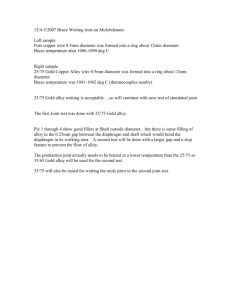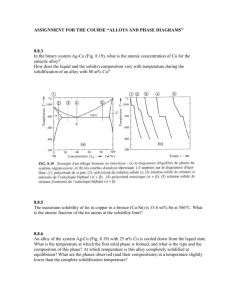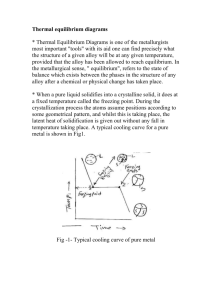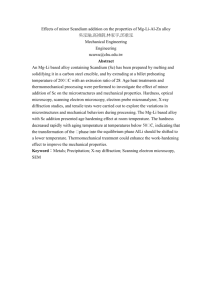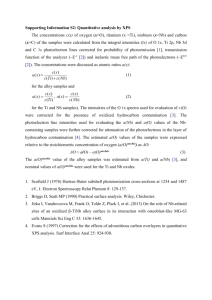Alloy 718 at Pratt & Whitney
advertisement
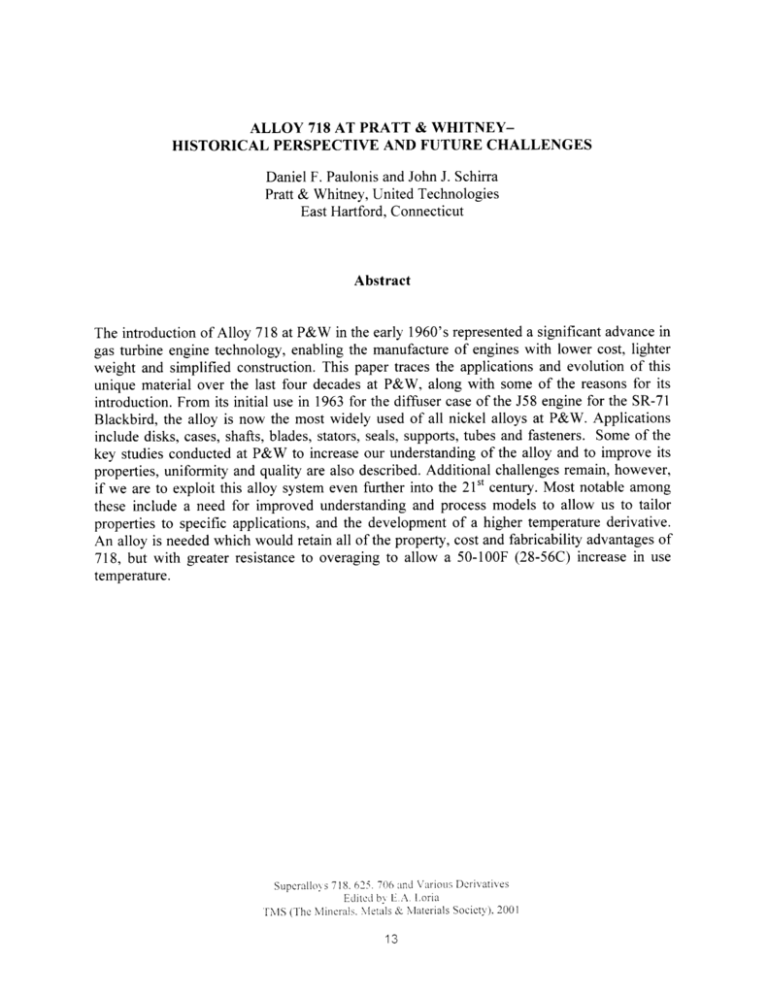
ALLOY 718 AT PRATT & WHITNEYHISTORICAL PERSPECTIVE AND FUTURE CHALLENGES Daniel F. Paulonis and John J. Schirra Pratt & Whitney, United Technologies East Hartford, Connecticut Abstract The introduction of Alloy 71 8 at P&W in the early 1960's represented a significant advance in gas turbine engine technology, enabling the manufacture of engines with lower cost, lighter weight and simplified construction. This paper traces the applications and evolution of this unique material over the last four decades at P&W, along with some of the reasons for its introduction. From its initial use in 1963 for the diffuser case of the 558 engine for the SR-71 Blackbird, the alloy is now the most widely used of all nickel alloys at P&W. Applications include disks, cases, shafts, blades, stators, seals, supports, tubes and fasteners. Some of the key studies conducted at P&W to increase our understanding of the alloy and to improve its properties, uniformity and quality are also described. Additional challenges remain, however, if we are to exploit this alloy system even further into the 21Stcentury. Most notable among these include a need for improved understanding and process models to allow us to tailor properties to specific applications, and the development of a higher temperature derivative. An alloy is needed which would retain all of the property, cost and fabricability advantages of 718, but with greater resistance to overaging to allow a 50-100F (28-56C) increase in use temperature. Supcrnllo) s 7 18. 6 2 5 . 706 ;mi1 \'arious Dcrivati\.es Eclitcti b> E .\, Loria rhlS (The hlinernls. lletals & hlaterials Society). 2001 13 Introduction Alloy 718 is the most widely used nickel alloy at P&W, accounting for over 50% of the superalloy content in some engines. And what an extraordinary material it is! H. Eiselstein's I INCO's gift to us (1) revolutionized many aspects of gas turbine engine design, and enabled these engines to be made at significantly lower cost, less weight and with simplified construction. Furthermore, it also allowed increased design flexibility for improved performance (and understanding its complex behavior has proven to be fertile ground for the fmits of many materials engineering careers). The combination of alloy 718's unique property balance, its ability to be processed as both wrought and cast products, and its weldability made it a natural candidate material for many gas turbine applications. Within only a few years of the initial announcement of lN718, P&W began to issue specifications and selected the material for critical applications. Most of the initial applications were on military engines (558, TF30 and FlOO), but from the late 1960's through the 1980's, commercial engine applications grew rapidly (JT9D, PW2000 and PW4000). Working closely with the supply base, P&W contributed to improvements in material quality and capability, primarily through process optimization to refine grain structure and reduce segregatioddefects. Some of the later applications of this alloy at P&W include several components in the very critical high-pressure turbopump of the Space Shuttle Main Engine (SSME), which first flew in 1995. Key milestones related to the incorporation of alloy 71 8 at P&W are shown in Figure 1. Figure 1. Key specification and application milestones related to the incorporation of Alloy 718 at P&W. The Early Years - Initial Applications and Increased Understanding Soon after the Huntington Alloys Division of INCO announced IN718 in 1959, P&W recognized its unique combination of attributes: high strength, weldability and fabricability. P&W conducted its own preliminary assessment and in March of 1962, issued its first series of material specifications that covered bar, forgings, sheet and weld wire, all from vacuum melted materials. Issuance of these specifications was hastened since there was a critical need at this time for Alloy 718 to support P&W's initial application, a complex welded diffuser case structure for the J T l l (eventually to become the 558) engine for the SR-71 Blackbird surveillance and reconnaissance aircraft (Figure 2). Development of the JTll for this supersonic (greater than Mach 3) aircraft began in the late 1950's. Because of the SR71 's speed, most of the engine operated at temperatures well in excess of 1000 F (538C). Therefore the engine was initially made almost Figure 2. First critical application of Alloy 71 8 at Pratt & Whitney.. . entirely of welded diffuser case in the 558 engine for the SR-71 Blackbird. Waspaloy (one of the strongest materials at that time). In Waspaloy, the difhser case welds were very prone to strain-age cracking, making it extremely difficult to produce a satisfactory part. Switching to Alloy 718 provided the answer. This initial success was soon followed by many other applications for wrought Alloy 71 8, including: TF30 (-1965) - Fabricated Turbine Exhaust Case and stator assemblies F 100 (- 1971) - Variable vanes, stators, cases JT9D (-1968) - Fabricated Diffuser Case ---First major application of Alloy 718 in a commercial P&W engine L The 718 material produced in these early days could not meet today's high quality standards. Vacuum processing was still in its infancy, and Alloy 718, with its high Nb content, was intrinsically difficult to melt without segregation or melt defects. Hence, this early material was characterized by significantly less uniformity than today's product, and the supply base pushed back on some of P&W's initial requirements for fine grain size. Another concern at this time was 718's tendency for notch sensitivity. Through work conducted at P&W and elsewhere, it became recognized that some amount of delta phase is needed at the grain boundaries to avoid notch brittleness, and this knowledge provided the basis for P&W's solution temperature requirements. Throughout its first decade of use, only minor revisions were made to P&W's wrought 71 8 specification (PWA 1010): Relaxation of grain size requirement from ASTM 6 to 4 Clarification of the solution heat treatment temperature Slight reduction in minimum allowable ductility levels. P&W7s first casting specification (PWA 649) was issued in 1965. Initially, only relatively small investment cast parts and details such as diffuser case and instrumentation bosses were produced. P&W's first application for a relatively complex Alloy 718 structural casting was the turbine exhaust case in the TF30 (-1969). This single casting replaced a welded assembly comprised of 38 individual details (Figure 3j, resulting in significant cost savings. In this same time period, an effort was made to replace the wrought diffuser case assembly in the JT9D, with a single piece casting. The goal was to achieve significant cost I savings at the % expense of added ii -3 t. weight resulting from lower cast properties. Wrought case Cast case 38 d e t a ~ l s I &tall However, this significantly larger Figure 3. First large Alloy 718 structural casting at P&W.. .. TF30 Turbine and more complex Exhaust Case. One casting replaced assembly of 38 parts. part proved to be a challenge beyond the capability of the industry. The cause for this program's lack of success was directly attributed to marginal casting quality regarding grain variation and soundness., i.e. porosity. Thus a cast case would have had higher then anticipated weights and lower then expected cost savings compared to the established wrought case. The previously mentioned TF30 case was successful since it was a simpler part to cast and had less demanding LCF requirements. F 1 /I l-rt During this initial decade of alloy 718's commercialization, P&W and others were able to take advantage of its unique properties without having a very good understanding of its strengthening mechanisms. Recognizing this need in the late 1960's, P&W conducted detailed studies to understand both the details of precipitation and strengthening - mechanisms in allc 71 8. It was known that the alloy had unus;allyAhigh strength for having a relatively low volume fraction of precipitate, as well as very slow precipitation kinetics compared to yr-strengthened alloys such as IN90 1, Waspaloy and Rene 41 (a key contributor to its excellent weldability). Even though the alloy had been in existence for almost ten years, uncertainty remained about the exact nature of its strengthening precipitates. Utilizing dark field transmission microscopy, a relatively new technique, it was unequivocally shown that a body Figure 4. Dark field transmission micrographs centered tetragonal phase, yfr, is the primary showing three variants of Y" and a bright field + . strengthening phase (Figure 4), although some yr is image showing high coherkncy strains also present (2). y" was shown to coarsen relatively rapidly above 1200F (649C), resulting in overaging and loss of strength. It was also demonstrated that the exceptional strength of Alloy 71 8 was due to the high coherency strains associated with y" (3). The Next Several Decades - Process Improvements and Expanding Applications By 1970, it was clear that alloy 718 was going to play an increasingly important role in gas turbine engine development at P&W. It was also becoming evident that this alloy was more complex than conventional yr-strengthened superalloys and required additional process development to enable P&W and others to fully exploit its potential. Over the next several decades, P&W built on its studies of the 60s and tapped into the significant developments generated by the metals industry and other aerospace companies regarding process optimization of alloy 718. In general the goal was to optimize process parameters to enhance the alloy's property balance and reproducibility. Major achievements included advances in ingot melting methods that dramatically improved cleanliness, minimized ingot defects such as freckles, and in general reduced segregation, enabling the casting of larger diameter ingots. Combined with improvements in billet conversion and forging methods leading to finer grain products and improved sonic inspectability, these developments resulted in an accelerated rate of application of the alloy into more critical engine components. Wrought alloy 71 8 was widely becoming accepted as the low cost, high capability material of choice at P&W for many static and fabricatedlwelded components. For example, alloy 718 was extensively used in the FlOO because of its positive effect on thrustlweight. However, in the early 1970's there was little incentive to use it for disks, considering the cost and time required to qualifL a new disk material. Commercial engines continued to use Waspaloy, IN901 and A286, while the more advanced military engines such as the FlOO successfully utilized GatorizedB powder metal IN1 00 for the most demanding applications. Several factors caused this to change in the mid-1970's. Weight and cost were becoming more of an issue for commercial engines, so a stronger, electron beam weldable (for drum rotor) alloy had growing appeal. This was also the time of the "Cobalt Crisis". In 1977 and 1978, there was a perceived (though not actual) cobalt shortage for several reasons. There were questions about the ability of Zaire to continue to provide Co at current levels because of political and economic uncertainties in that country and the National Defense Stockpile in the U.S decided to stop selling Co in 1976. The price of Co increased dramatically (from $6.40 per pound in Dec 1977 to $25 per pound in Feb 1979)' noticeably raising the price of Co-containing superalloys and making alloy 71 8 (containing no Co), much less expensive in comparison. P&W qualified both conventional (PWA 1010) and high strength (PWA 1085) versions of alloy 718 for disks in 1980 and 1981, respectively. The high strength specification has a finer grain size requirement of ASTM 6 (vs. ASTM 4) to assure higher strength and fatigue capability. The move toward finer grain product was enabled by the concurrent and fortuitous development of improved ingot casting, billet conversion and forging methods in the supply base. P&W's initial disk applications consisted of lower cost direct replacements for Waspaloy in the JT8D engine (1" turbine and 1 3 ' ~ compressor disks) around 1980. In 1982, development began on the PW4000, designed with a large core to meet thrust growth requirements for Drum Rotor I future wide-body aircraft. To meet cost and weight goals, electron beam (EB) welded Ti and Ni drum rotors were selected as the optimum fabrication path for the high compressor. EB welding technology for Ti was well developed at P&W, having been used since at least the mid-19701s, but the technology needed to be developed for alloy 718. Problems to be overcome included weld heat affected zone microcracks as well as undercut and underfill. An extensive development program was completed over the next several years, and these issues were solved through careful control of weld parameters and microstructure in the EB weld zone. A finish machined 3-stage alloy 718 PW4000 drum rotor is shown in Figure 5. From the mid-70s through the mid-80s, P&W expanded its efforts to develop critical cast alloy 718 components (4). Working closely with the supply base, especially PCC, P&W made notable advances in the processing of cast alloy 718. In essentially all activities, the objective of these efforts was to push cast properties closer and closer to those of wrought materials, primarily through grain size refinement and defect elimination. Success in meeting these goals meant P&W could better take advantage of the cost savings associated with single piece castings relative to more labor intensive welded assemblies. Building upon the successful incorporation of an alloy 718 casting in the TF30 turbine exhaust case, but recognizing the casting process limitations at that time, additional applications for castings were incorporated. These included the relatively small diffuser in the FlOO engine -1972 and one-piece statodcase components in 1975 in the TF30 (Figure 6). At about this same time, P&W began development of the JTlOD (precursor to the PW2000), and for cost reasons, there was a strong drive to incorporate a premium, high quality casting for Figure 6. First one-piece cast the diffuser case in this engine. For several years, P&W statorlcase component for TF30 conducted extensive development and characterization J programs, and concluded that subsurface porosity was the most significant impediment to the wider use of 718 castings because of its debiting effect -60 50 on LCF properties. Incorporation of hot isostatic 40 pressing (HIP) was the obvious answer, and 3 0 -7-P&W continued its development activity along ---- -2 0 these lines for the next several years. Included lo-- 0 were studies to identi@ an optimum HIP None 2100 2150 2175 2200 2250 temperature which was high enough to close all HIP T e m p e r a t u r e ( F ) porosity and homogenize the material but not so Figure 7. Effect of HIP temperature on LCF high as to cause incipient melting of casting life segregation which reduced fatigue capability. P&W selected 21 75F (1 191C) as a result of this study (Figure 7) and issued specification PWA 1469 covering cast + HIP alloy 71 8 in April 197'9. ] 7 - - 1 Immediately upon issuance of this specification, a decision was made to apply it to the JT8D first stage vane inner support, the first application for cast + HIP 718. This part was already being made from cast alloy 718 but it was plagued by excessive porosity. A series of critical diffuser case applications quickly followed, beginning with the PW2037 centerbody in 1981, then the V2500 (first one-piece diffuse case), and finally the PW4000 in about 1984 Figure 8). This was the largest structural casting made at the time; weighing over 4 0 0 ~ o u n d s(182 kg). It has a one-piece three-wall construction, five attachment flanges and 71 pads and bosses. cast + HIP Diffuser Case In addition to porosity, which was dealt with very effectively through the use of HIP, another area of concern was the propensity of alloy 718 to form localized areas of laves phase in large castings (Figure 9). Laves forms as a result of Figure 9. Laves phase segregation and is promoted by an inability to control cooling rates due to segregation in large castings. during solidification. It is a brittle phase that can have a very detrimental effect on LCF as well as weldability. The 2 175F (1 19 1 C) 1 / HIP cycle can sometimes solution laves, but this does not occur in all cases. In cases where laves must be avoided but the casting configuration doesn't allow, P&W developed a pre-HIP homogenization treatment. This treatment eliminates segregation, decreases incipient melting and maximizes LCF capability Finally, it was determined that overall mechanical properties can be improved through heat treatment optimization. This took the form of two modifications to the standard heat treatment: addition of a stabilization cycle and increases in the y" precipitation temperatures. Effective homogenization through HIP significantly slowed the delta phase precipitation reaction such that a 1600F hold was reauired prior to the solution cycle to generate sufficient grain I 1 nStandard Aae lUu Yield Tensile slightly from 1325F (718C) + 1 l5OF (621C) to 1350F (732C) +1225F (663C). Figure 10 shows the significant level of improvement resulting from this change. Both modifications brought the primary properties to within 75% or higher of those exhibited by coarse grain wrought alloy 7 18. PWA1472 - A High Strength Version of Alloy 718 In the early 1980's, P&W recognized that significant weight benefits could be realized with a higher strength modification of Alloy 718 for large structural casting applications such as diffuser cases. After several years of intense development, a composition was defined and PWA1472 specification was issued for cast + HIP product in September 1986. Chemistry modifications consisted primarily of raising the Ti content to 2% and the Nb content to 6% while lowering the Cr content from 17% to 12%. The reduction in Cr content was found to significantly reduce the laves phase forming behavior of the Nb-containing alloy systems. This modified version of Alloy 71 8 offers about a 25% increase in yield strength and creep-rupture properties approaching those of wrought material (4), albeit with some decrease in crack growth and processing capability. PWA1472 has been selected for the diffuser case in P&W's F 1 19-PW-100 which powers the United States Air Force F-22 Raptor air dominance fighter. SSME (Space Shuttle Main Engine) Applications In 1986, NASA contracted with P&W to produce highpressure turbopumps for the Space Shuttle's main engine. Together, a pair of high-pressure turbopumps delivers liquid hydrogen (fuel) and liquid oxygen (Lox) to the shuttle engine's main combustion chamber for ignition (Figure 1 1). The 1" firing of a P&W turbopump occurred in 1990 and the first flight with one P&W Lox pump took place on July 13, 1995. These pumps are routinely used in today's shuttle missions. Figure 11. Space Shuttle Main Engine Several of the more interesting and unique applications for alloy 718 at P&W are in these turbopumps. Alloy 718 was utilized initially by Rocketdyne in their earlier versions of the SSME turbopumps ( 5 ) , and P&W continued and enhanced the application of alloy 718 in its turbopumps. Alloy 718 is an ideal material for many SSME components because of its high strength, its excellent weldabilitylfabricability, its ability to operate in liquid oxygen and hydrogen environments and its relatively good toughness and other properties at cryogenic temperatures. Wrought Alloy 71 8 is used for the impeller and pump side inducer, and cast 71 8 is utilized in the main pump housing. Photographs of each of these are shown in Figure 12. I I I Inducer I I Impeller I Pump Housing I Figure 12. Alloy 718 components used in P&W9sSpace Shuttle Main Engine. I Because of the unique requirements of these components (relative to P&W's more traditional gas turbine parts), several non-standard processing methods are employed. The wrought components are given a high temperature solution treatment to solution all delta phase, since high temperature notch-brittle stress rupture problems are not a concern with this application, and this microstructure has a significantly beneficial effect on toughness at cryogenic conditions. The pump housing is quite intricate, and is manufactured from three fine grain ~icrocast-X' investment castings, electron beam welded together into a single assembly. The manufacture of this housing is much simpler than that of the earlier Rocketdyne housing, which was a welded assembly of over 200 individual wrought and cast details. Howmet's ~icrocast-X@ process was selected for this part because it not only offered the option to cast such a complex part with few casting defects, but the finer grain size also provided improved strength, resulting in a lighter weight design. Additional details of this process as applied to SSME parts were provided by Howmet at a prior 71 8 conference (6). Machinability Low raw material cost has already been mentioned as one of the key reasons for Alloy 718's popularity and proliferation of applications at P&W. But another factor that adds to the cost of manufacturing a component:is the cost of machining. Because of Wrought lnconel71E A 20 25 30 35 40 45 50 Hardness (Rc) Figure 13. Factors affecting the machinability of Alloy 718. ASTM 8-1 ASTM 1-2 ASTM 4-6 the large volume of Alloy 7 18 used by P&W and the extensive machining required, P&W and the United Technologies Research Center expended significant effort to understand the metallurgical factors which influence the machinability of this alloy (7). Factors such as fabrication technique (wrought, cast, or cast + HIP), hardness, grain size and carbon content were studied and all were found to influence machinability (Figure 13). The following general trends were identified: Machinability is relatively independent of product form at hardnesses < 38 Rc At hardnesses > 38 Rc (fully heat treated), the machinability of the HIP material begins to decrease more rapidly than the other product forms Machinability improves significantly for grain sizes finer than ASTM 5 Reducing carbon content improves the machinability of HIP material to levels equivalent to fully heat treated wrought material. Extent of Alloy 71 8 Usage in P&W Engines By any measure, alloy 718 is by far the most widely used nickel alloy at P&W. In a study conducted in the mid-1990's, over 40% of all Ni alloy purchased by P&W, including both wrought and cast product forms, was alloy 718. This amounted to over 4 million pounds in 1995. For a specific engine, the PW4000, Ni accounts for approximately 39% of engine weight, and alloy 718 accounts for 57% of this amount (Figure 14), or a total of about 1670 pounds (760 kg.). Pending further developments, this engine model, which was designed in the 1980's, may likely represent the peak in percentage of 718 usage. As newer engine designs drive toward higher efficiencies and lower weight, the temperatures of many components are gradually increasing, resulting in a shift from alloy 71 8 towards higher temperature capability materials. An expanded discussion of this trend and potential solutions is contained in the next section of this paper. Other Cast Airfoil Figure 14. Overview of material usage in the PW4000 engine. 21 Recent Activity and Future Challenges Since its initial introduction in 1963, alloy 718 experienced a period of rapid growth and application into a broad range of gas turbine and rocket engine components and processing routes at P&W due to its unique characteristics and affordability. Much of the 1960's was devoted to understanding the physical metallurgy, processing limits, and general mechanical property capabilities of this unique superalloy. Since then, most development activity has focused on reducing product variability and improving process robustness, achieving equivalent or improved property balance at lower product cost, and capturing more of the alloy's intrinsic design capability through careful control of processing and microstructure. From an economic perspective, the use of investment cast alloy 718 as a replacement for wrought assemblies has been a phenomenal success, despite somewhat reduced property levels of castings compared to forgings. Alloy modifications such as PWA 1472 have been successful in recovering some of the capability; the challenge remains, however, to achieve wrought property levels through use of lower cost processes. Some of the major process technologies that have demonstrated the potential for achieving wrought property levels include powder injection molding (PIM) and vacuum die casting for high volume, relatively small but complex configurations such as compressor airfoils and brackets. Sprayforming has been demonstrated to have great potential for manufacturing static structural parts (in the spray + HIP condition) and rotating components (as a forging preform). While none of these technologies has yet achieved production incorporation, each has been evaluated through either engine test (sprayforming) or extensive specimen characterization. One obstacle to introducing new process technologies for alloy 718 is the already low material and metalworking costs using currently available technologies relative to other superalloys. Thus, it can be difficult to justifL the financial investment required to develop and certify a new process. In wrought material, there has been a clear trend over the past decade towards finer grain sizes and improved homogeneity. Process modeling and improved process controls and sensors in ingot remelting, billet conversion, forging and heat treatment have enabled better control and refinement of grain structure and delta phase distribution. This has resulted in a significant improvement in the design capability for the alloy relative to initial property levels. With the demand for higher efficiency and improved reliability for advanced turbine engines, this refined product structure and enhanced capability has enabled alloy 71 8 to remain the material of choice for many applications. Despite the enormous success of alloy 71 8, several significant challenges must be addressed if this unique material (or derivative) is to remain the predominant nickel base superalloy well into the 21" century. Chief among these is the need to simultaneously improve the temperature capability and time dependent fracture behavior of the alloy system. A persistent trend towards increased compressor and turbine efficiencies are driving designs to higher operating temperatures with a concurrent requirement for increased on-wing operational time between inspection and overhaul (to reduce total life cycle cost of the propulsion system). These related issues of limited temperature capability and resistance to environmentally assisted crack growth have long been recognized as the Achilles heel for alloy 718. Numerous attempts have been made over the past 20 years to improve temperature capability, typically through chemistry modifications involving Co and Ta additions, but none has been entirely successful. In cast form, Rene 220 exhibits increased thermal stability, but in wrought form it continues to suffer from accelerated dwell crack growth at higher temperatures (8). P&W believes that a concerted industry-wide activity (to ensure broad acceptance) will be required to fully exploit 22 this development opportunity, and some government funded initiatives are currently moving in this direction. Key in any such effort will be effective utilization of increasingly sophisticated material and process modeling tools that have only recently become available. In addition, the foundation established during the 1980's into factors controlling time dependent crack growth must be built upon to ensure the durability and safe operating behavior of the alloy under increasingly demanding design conditions. The authors express their gratitude to Robert Hatala and Daniel Bales for their great help in providing many of the historical facts surrounding development of this material at P&W and to Robert Hatala for his assistance in editing this paper. We also want to thank the scores of individuals at P&W who contributed to the development and increased knowledge about Alloy 71 8 over the last four decades. References I . H. L. Eiselstein, "Metallurgy of Columbium-Hardened Nickel-Chromium-Iron Alloy," Advances in the Technology of Stainless Steel and Related Alloys, ASTM STP No. 369, 62-77, 1965. 2. D. F. Paulonis, J. M. Oblak, and D. S. Duvall, "Precipitation in Nickel-Base Alloy 718," Trans. ASM . 6 2 (1969), 61 1-622. 3. J. M. Oblak, D. F. Paulonis and D. S. Duvall, "Coherency Strengthening in Ni Base Alloys Hardened by DO2?y" Precipitates," Met Transactions, 3 (1974), 143- 153. 4. R. W. Hatala, "Alloy 718 Castings in Gas Turbine Engines: An Overview," (Paper presented at the 1" International Conference on the Metallurgy and Applications of Superalloy 7 18, Pittsburgh, PA, June 1989) 5. R. P. Jewett and J. A. Halchak, "The Use of Alloy 718 in the Space Shuttle Main Engine," Superalloys 718, 625, and Various Derivatives, ed. by E. A. Loria, TMS, 1991, 749-760. 6. G. K. Bouse, R. A. Dunham and J. Lane, "Mechanical Properties of Fine-Grain MicrocastX@ Alloy 718 Investment Castings for SSME, Gas Turbine Engine, and Airframe Components,", Superalloys 718, 625, 706 and Various Derivatives, ed. by E. A. Loria, TMS, 1997,459-468. 7. J. J. Schirra and D. V. Viens, "Metallurgical Factors Influencing the Machinability of Inconel 718," Superalloys 718, 625, 706 and Various Derivatives, ed. by E. A. Loria, TMS, 1994, 827-838. 8. E. A. Loria, "Rene 220: In Retrospect and Prospect," Superalloys 718, 625, 706 and Various Derivatives, ed. by E. A. Loria, TMS, 1994, 739-750.


